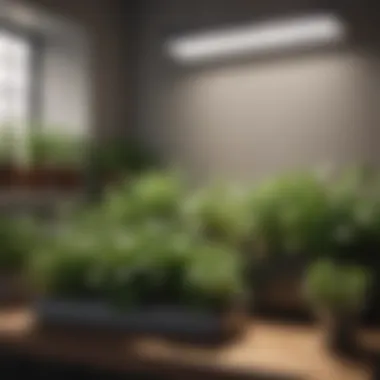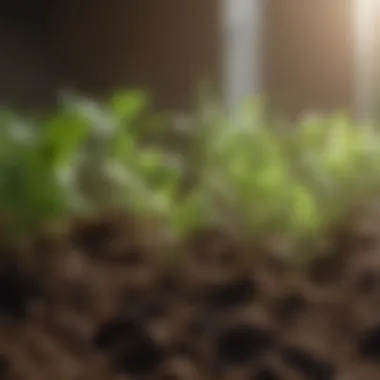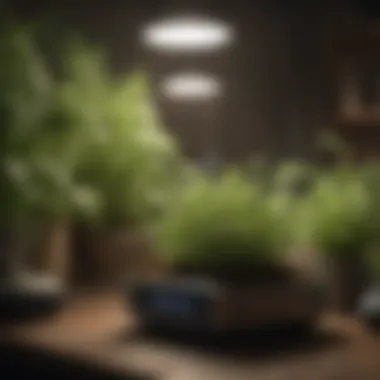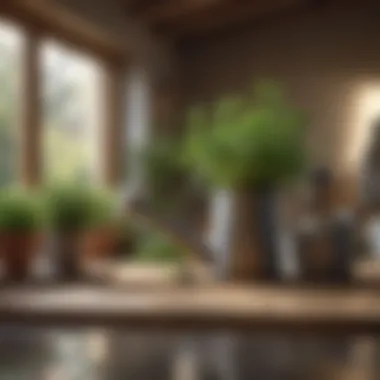Indoor Herb Gardening: Grow Without Sunlight


Intro
Growing herbs indoors can seem like a challenging task. Many people believe that direct sunlight is a requirement for plant growth. However, this is not necessarily valid. There are innovative and practical solutions for cultivating healthy herbs without exposing them to natural light. This article will explore various techniques and resources that aid in successful indoor herb gardening, even in the absence of sunlight. By understanding alternative light sources, suitable soil options, and environmental controls, readers can create an optimal atmosphere for their plants.
Key Points to Discuss
- Understanding alternative light sources
- Choosing the right herbs for indoor growth
- Techniques for soil and water management
- Strategies for environmental control and maintenance
This comprehensive examination will equip homeowners, gardening aficionados, and design enthusiasts with the knowledge to nurture a thriving indoor herb garden.
Design Inspirations
Creating a pleasing indoor herb garden goes beyond plant care. It extends to aesthetics and functionality. The design should be both inspiring and conducive to growth. Incorporating plants into the home can enhance both decor and moods. Here are some design inspirations:
Trending Styles
- Minimalist Planters: Simple, sleek lines and neutral colors can create a serene environment.
- Vertical Gardens: Maximizing space using wall-mounted planters adds a unique style and saves floor space.
- Container Arrangements: Grouping different containers, made from materials like clay or metal, can add character.
Color Palettes
Selecting the right colors for your indoor herb setup can elevate the overall atmosphere.
- Earthy Tones: Shades of green, brown, and beige create a natural look.
- Pop of Color: Bright colored pots can add vibrancy to the space.
- Monochrome: White pots and containers create a clean aesthetic and create contrast with green herbs.
A tailored design can inspire consistency in plant care and growth.
Maintenance and Upkeep
Caring for indoor herbs requires attention beyond basic care. Developing a systematic approach enhances both plant health and the indoor environment.
Seasonal Maintenance Checklist
- Winter: Reduce watering frequency and ensure plants are near light sources.
- Spring: Prune plants for growth and check for pests.
- Summer: Monitor humidity levels and water more frequently.
- Fall: Prepare herbs for cooler temperatures and reduce fertilization.
Cleaning and Organization Tips
- Regular Cleaning: Dust off leaves and clean pots to promote healthy growth.
- Organize Space: Keep tools and supplies within easy reach to encourage maintenance activities.
"Creating a structured maintenance routine is key to a thriving herb garden."
By embracing thoughtful design and proper maintenance, anyone can cultivate a fruitful indoor herb garden without depending on sunlight.
Preface
The necessity for indoor gardening is increasingly evident in today’s world. Urbanization limits outdoor space, while the desire for homegrown produce continues to rise. Herbs, in particular, are among the most popular choices for indoor gardening enthusiasts. They provide flavors for meals and offer various health benefits, making them highly sought after. Indoor gardening facilitates personal engagement with the plant life, enhancing well-being and stress relief.
The discussion will not only present a step-by-step approach but will also highlight the benefits and considerations of each method. With specific insights into popular varieties of herbs and their care requirements, readers can look forward to a practical guide designed for their unique circumstances. For those willing to venture into a sunless herbal haven, the rewards can be substantial.
Understanding Light Requirements
Photosynthesis and Light
Photosynthesis is the process by which plants convert light energy into chemical energy. Light plays an essential role in this process. When growing herbs indoors, you need to understand the spectrum of light that plants need for photosynthesis. Light mostly falls into two categories: red and blue.
- Red light promotes flowering and fruiting.
- Blue light is important for leaf growth and vegetation.
These light wavelengths help stimulate chlorophyll production, which is necessary for photosynthesis. Without adequate light, herbs may become weak, leggy, or fail to produce leaves at all. Understanding how different wavelengths affect growth can lead to better outcomes when using artificial lighting.
Types of Light Sources
Choosing the right type of light source is vital for successful indoor herb gardening. There are several lighting options, each having its pros and cons. Here are some common types:
- LED Grow Lights: These lights are highly energy-efficient and can be tailored to specific light spectrum needs. Their longevity and low heat emission make them a popular choice for indoor gardeners.
- Fluorescent Lights: These lights come in tube or compact forms. They provide a decent amount of bright light suitable for growing herbs. They are affordable and come in various color temperatures, ideal for targeting specific growth stages.
- Incandescent Lights: While these are not highly recommended for growing herbs, they can be found in many households. Incandescent bulbs emit a lot of heat and have a poor efficiency profile when it comes to providing usable light for plants.
For homeowners and gardening enthusiasts, understanding which light source to use will minimize challenges and preserve resources. It's not only about having light but having the right kind of light.
"The right lighting can make all the difference in the health of your indoor herbs. Understanding light requirements is an essential part of successful indoor gardening."
Experimenting with these light sources allows for tailored growth and can lead to a richer experience growing herbs indoors.
Choosing the Right Light Source
When deciding on a light source, consider factors like energy efficiency, heat output, and spectrum of light. Energy-efficient lights save money and produce less heat. Excess heat can dry out soil and stress plants, so controlling temperature is vital. Additionally, different herbs have varying light requirements. Understanding these needs helps in making informed decisions about the light source.
Each lighting option presents its own set of benefits and limitations. Here are a few options to consider:


- Flexibility in positioning: Different setups allow for light placement at varying distances from plants.
- Cost-effectiveness: Evaluate the upfront cost versus long-term savings in energy bills.
- Plant growth: Some lights foster quicker growth and larger plants compared to others.
Using a suitable light source can make a significant difference in indoor herb gardening. Now, let's consider specific types of light sources available.
LED Grow Lights
LED grow lights have risen in popularity for indoor gardening. They are efficient and provide a full light spectrum that supports photosynthesis. The benefits of LED grow lights include:
- Energy efficiency: They consume less electricity than traditional options. This factor is important for long-term affordability.
- Low heat output: LED lights emit minimal heat, reducing the risk of overheating the plants. This allows for a closer placement without harming the herbs.
- Longevity: LED grow lights generally last longer than other types of bulbs, making them a good investment for serious indoor gardeners.
While the initial investment can be higher, the overall savings and improvement in plant health often justify the cost.
Fluorescent Lights
Fluorescent lights are another viable option for indoor herb gardening. They are commonly used and produce good results for many herb varieties. Here are some features of fluorescent lights:
- Affordability: They are generally more affordable than LEDs, making them accessible for beginner gardeners.
- Good for small spaces: They provide sufficient coverage for smaller gardening areas without taking up much room.
- Moderate heat: Fluorescent lights produce more heat than LEDs, so it may be necessary to keep them at a distance to avoid stressing plants.
These lights work best for herbs that require moderate light levels. Regular monitoring and adjusting of the light distance can optimize growth.
Incandescent Lights
Incandescent lights are the least recommended for indoor herb growth. Although they may provide light temporarily, they come with downsides:
- High heat output: Incandescent bulbs generate a lot of heat, which can easily damage sensitive herbs. This heat can dry soil quickly, leading to inconsistent watering needs for the plants.
- Inefficiency: They use much more energy compared to LED and fluorescent options, making them less economical long-term.
- Limited spectrum: They do not provide a full spectrum of light suitable for plants, limiting their effectiveness for serious indoor herb gardening.
While they may seem convenient for short-term use, relying solely on incandescent lights will likely result in poorer plant health.
For optimal growth of your indoor herbs, invest in a suitable lighting system that meets their individual needs while also considering energy efficiency and heat production.
Soil and Containers for Indoor Herbs
Choosing the Right Soil Mix
Selecting the right soil mix is vital for ensuring your herbs thrive in an indoor environment. Herbs generally prefer well-draining soil that retains some moisture while allowing excess water to escape.
A suitable soil mix can be composed of potting soil, perlite, and vermiculite. The potting soil offers essential nutrients while perlite aids in drainage. Vermiculite can help in retaining some moisture without making the soil waterlogged. This blend not only promotes root health but also supports the plant structure necessary for optimal growth.
When considering soil, it's important to avoid garden soil, as it can compact too much and may carry pests and diseases. Instead, look for sterile potting mixes that are specifically designed for container gardening. Dedicated herb mixes are also available and might contain organic matter to boost plant vitality.
Containers and Drainage
Proper containers contribute significantly to successful indoor herb growth. Choosing the right container goes beyond aesthetics; it impacts the overall growth and health of the plant.
Containers should have adequate drainage holes. This prevents water from accumulating at the bottom, which can cause root rot, a common affliction among indoor herbs. Clay pots are generally preferable for herbs because they allow moisture to evaporate more efficiently than plastic alternatives. However, if you choose plastic containers, ensure they are designed with good drainage capabilities.
In addition to drainage, consider the size of the container. A larger container can accommodate herb roots better and provide enough space for growth. If your herbs thrive and require extra space, repotting can be done, moving them to bigger pots as needed. The container material also matters; while clay pots hold the moisture but allow airflow, plastic pots may retain more heat but less moisture.
"The success of indoor herb gardening largely relies on choosing the right soil and containers." - Indoor Gardening Enthusiast
To summarize, remember to use a proper soil mix and select containers with good drainage. Both of these factors combined enhance the environment in which your herbs grow, making them strong and vibrant even without sunlight.
Popular Herb Varieties for Indoor Growth
Growing herbs indoors not only offers the pleasure of cultivation but also enhances culinary experiences. Selecting the right herb varieties is essential for successful indoor gardening. This section explores popular herbs that thrive indoors without sunlight, highlighting their specific requirements and benefits.
Basil
Basil is a favored choice among indoor gardeners due to its fragrant aroma and culinary versatility. This herb requires warmth and humidity to flourish. It thrives well under artificial lights, especially LED grow lights. Regular pruning helps encourage bushier growth and prevents flowering, which can diminish flavor. Basil is generally used in dishes like pastas, salads, and sauces, making it a staple in many kitchens.
Mint
Mint is robust and easy to grow indoors, making it ideal for homeowners looking for low-maintenance herbs. Its lush foliage grows quickly under sufficient light and humidity. Mint prefers well-drained soil and frequent watering, as it does not like to dry out completely. The leaves can be used fresh, in beverages, or as flavor enhancers in various dishes. When growing mint, consider using containers to prevent its invasive nature from taking over.
Parsley
Parsley is another excellent indoor herb that is nutritious and versatile. There are two main varieties: curly and flat-leaf (Italian). It requires moderate sunlight or fluorescent lighting to thrive. Regular watering is pivotal, but care must be taken to avoid waterlogging, which can lead to root rot. Parsley is often used as a garnish, but it can also enhance the flavor of many dishes, providing both color and nutrition.
Thyme
Thyme is a perennial herb that adapts well to indoor conditions. This herb requires less moisture than others, making it suitable for gardeners who may not have much time for maintenance. Well-drained soil is crucial for thyme, and it can tolerate lower light levels compared to basil or mint. Thyme complements a variety of culinary applications, particularly in Mediterranean cuisine, enhancing the flavor of roasted meats, vegetables, and stews.
Key Consideration: When selecting herb varieties for indoor gardening, consider their specific growth needs, such as light, water, and soil type. This ensures a thriving indoor herb garden.
Environmental Control for Optimal Growth


Environmental control is crucial for the successful growth of herbs indoors, especially in the absence of natural sunlight. This control involves managing temperature, humidity, and air circulation, all of which significantly affect plant health and growth. By ensuring optimal conditions, indoor gardeners can create an environment that resembles the ideal outdoor growing conditions. This section will explore key factors that contribute to a suitable indoor herb garden.
Temperature and Humidity
Temperature and humidity play a vital role in the growth of herbs indoors. Most herbs prefer a temperature range between 60-75°F (15-24°C). Extreme temperatures can stress plants, leading to stunted growth or even death. It is critical to avoid drastic fluctuations in temperature. For instance, placing herbs near heaters or drafty windows can create uneven conditions that disrupt growth.
Humidity is equally important. Herbs generally thrive in humidity levels between 40% and 60%. If the air is too dry, which can happen in winter months or in air-conditioned homes, plants may suffer from leaf drop or become susceptible to pests. One effective way to increase humidity is to use a humidifier or even place a tray of water near the plants to create a microenvironment. Regularly misting the plants can also help maintain adequate humidity levels.
Monitoring these factors with a thermometer and hygrometer can ensure that the growing conditions remain within the desired ranges.
Air Circulation
Good air circulation is another important element for indoor herb growth. Proper airflow around plants helps prevent the development of mold and mildew, which can be particularly problematic in closed environments. Stagnant air can lead to the accumulation of moisture on leaves, creating a breeding ground for fungal diseases.
To improve air circulation, consider the following techniques:
- Using fans: Small oscillating fans can keep the air moving, helping to regulate temperature and humidity.
- Spacing plants: Ensure herbs are not overcrowded. Adequate spacing allows for better air movement around each plant.
- Ventilation: If possible, open windows or doors to let fresh air in, especially on milder days.
Ultimately, maintaining good airflow along with the right temperature and humidity levels will create a thriving environment for your indoor herbs. All these elements combined will contribute to optimal growth and longevity of your indoor plants.
Proper environmental control significantly enhances the productivity and health of indoor herbs, providing the right foundation for successful gardening.
Watering Techniques for Indoor Herbs
Effective watering is critical for growing herbs indoors, especially without direct sunlight. Proper watering techniques help maintain the balance of moisture that herbs require for growth. Over-watering or under-watering can lead to various issues, including root rot or wilting. Thus, understanding the specific needs of indoor herbs relative to their environment becomes essential.
Understanding Water Needs
Herbs have different water requirements based on their species, growth stage, and potting conditions. Most common indoor herbs like basil, mint, and parsley have moderate water needs. Their roots may rot if they sit in excess water. On the other hand, dryness can hinder their growth.
When assessing water needs:
- Soil type: A well-draining potting mix will absorb and release moisture effectively. Using a mix that retains some moisture without becoming soggy is best.
- Air humidity: In drier environments, herbs may require more frequent watering. Conversely, if the indoor air is humid, they may need less.
- Plant health: Observing your herbs regularly helps gauge their water demands. Yellowing leaves often indicate over-watering, while wilting shows a lack of moisture.
Monitoring moisture levels in the soil is crucial. Using your finger to check the top inch can help determine if watering is necessary. Observations should be made consistently to develop an understanding of when your herbs need water.
Watering Frequency
Watering frequency varies depending on several factors such as plant type, environmental conditions, and pot size. On average, most indoor herbs will require watering every 5 to 7 days.
- Seasonal Changes: During warmer months, herbs may need more frequent watering as they grow actively. In contrast, cooler months might reduce their water demand.
- Growing medium: If using clay pots, they often dry out quicker than plastic ones. Adjust your watering routine accordingly.
- Observation: Monitoring the moisture level in the soil can help establish a routine. If the top inch is dry, it's time to water.
In summary, effective watering is vital for indoor herbs. Understanding their unique needs and observing conditions will guide proper watering techniques, ensuring vibrant and healthy plants.
Fertilizing Indoor Herbs
Fertilizing herbs grown indoors is crucial for their health and productivity. Indoor herb gardens, devoid of natural soil nutrients, require careful attention to their nutritional needs. When herbs are well-fertilized, they are more likely to thrive and produce aromatic leaves, enriching your cooking with fresh flavors.
When you grow herbs indoors, especially without sunlight, they rely heavily on external nutrients. The right type of fertilizer not only aids in growth but enhances flavor and aroma. Additionally, the absence of sunlight can quickly deplete nutrients in the soil, making it essential to fertilize regularly to avoid deficiencies.
Choosing the Right Fertilizer
Selecting the appropriate fertilizer for your indoor herbs is fundamental. There are several options available, and understanding their composition and utility is key.
- Organic Fertilizers: These fertilizers are derived from natural sources. They enrich the soil but may have lower nutrient concentrations. Examples include compost, worm castings, and fish emulsion. They also improve soil structure and its ability to hold nutrients.
- Chemical Fertilizers: These synthetic options often provide a higher concentration of nutrients. They are usually more cost-effective for those looking to boost growth quickly. However, overuse can lead to nutrient burn, causing harm to the plants.
- Balanced Fertilizers: Look for fertilizers with an N-P-K ratio (Nitrogen-Phosphorus-Potassium) suitable for herbs. A balanced formula, like 10-10-10 or 20-20-20, provides a well-rounded nutrient profile.
- Liquid Fertilizers: These are easy to apply and promote faster absorption by the roots. They are ideal for quick replenishment of nutrients, especially for indoor plants under artificial light.
- Slow-Release Fertilizers: These provide nutrients over time, reducing the need for frequent application. They are beneficial for inexperienced gardeners as they minimize the risk of over-fertilization.
Understanding the specific needs of your herbs can guide you towards the best fertilizer option.
Fertilizing Schedule
Establishing a fertilization schedule for indoor herbs is essential to maintaining their growth and health. The frequency and timing of fertilizer application can significantly impact your herb garden's success.
- Initial Fertilization: Begin fertilizing about two weeks after planting or transplanting young herbs. This allows them to settle into their environment.
- Regular Feedings: Apply fertilizer every four to six weeks during the growing season, which is typically spring and summer for most herbs. Adjust this based on the specific herb variety and their growth response.
- Dilution: When using liquid fertilizers, dilute them to half the recommended strength to avoid burning the roots. Always water your herbs thoroughly after fertilizing.
- Monitoring Growth: Keep an eye on the growth of your herbs. If they show signs of yellowing leaves or stunted growth, consider adjusting your fertilization frequency or the type used.
- Seasonal Changes: In winter, when growth slows down for many herbs, reduce fertilization to once every two or three months. This prevents nutrients from accumulating in the soil, which can be detrimental.
Regularly evaluating the condition of your herbs will guide you on when to feed them, as healthy plants typically exhibit vibrant color and robust growth.
Pest and Disease Management
Indoor gardening introduces a unique set of challenges, especially when it comes to managing pests and diseases. This section is critical because without proper management, even the most cultivated herbs can become victims to invasive pests or disease. Identifying these threats early can save your plants and ensure a healthy growth environment.
Identifying Common Pests
Keeping a close eye on your indoor herbs is essential. Common pests such as aphids, spider mites, and whiteflies can thrive in inner environments.
- Aphids tax the plants by sucking sap from leaves, which can stunt growth.
- Spider mites can create fine webs on the foliage, indicating significant damage.
- Whiteflies are another pest that appears as tiny white moths and can quickly reproduce if not controlled.


To identify these pests, inspect the undersides of leaves regularly. Look for unusual spots or bugs. Using a magnifying glass can help spot smaller pests across your plants.
Preventive Measures
Preventing pest infestations is always more effective than dealing with them after they occur. Here are several effective strategies:
- Ensure Proper Airflow: Good airflow helps keep humidity down, making it an unfriendly place for pests.
- Maintain Cleanliness: Regularly clean your plant containers and surrounding areas to remove eggs and debris that may attract pests.
- Use Companion Plants: Some herbs naturally repel pests. For example, plant basil with tomatoes to deter common pests.
- Natural Insecticides: Products containing neem oil can be effective in controlling pests while being safe for your plants.
Always read the instructions carefully before applying any treatment, as overuse can harm your herbs.
By actively monitoring and implementing these preventive measures, you can create a covert defense against pests and diseases, allowing your indoor herbs to thrive.
Harvesting and Using Indoor Herbs
Harvesting and using indoor herbs is a crucial aspect of indoor gardening. Knowing when and how to properly harvest herbs ensures that you not only enjoy their full flavor but also promotes continued growth. Proper harvesting techniques can lead to healthier plants and more abundant yields.
It is essential to recognize that every herb has its best time for harvest. For instance, basil is often best when the leaves are young and tender, while mint can be harvested when it reaches a height of about six inches. By understanding the optimal harvest times, you can enjoy fresh herbs at their peak flavor.
Using your harvested herbs effectively is just as important. Fresh herbs can elevate any dish and offer health benefits. Integrating them into meals allows for culinary creativity. Furthermore, you can dry or freeze excess herbs for later use. This flexibility means that even if a small indoor garden yields an overabundance, you can save the rich flavors for downtime when fresh herbs aren't at hand.
"Harvesting herbs regularly encourages new growth and helps maintain the plant's vigor."
Best Practices for Harvesting
Harvesting indoor herbs should be done with care to promote healthy growth. Here are some best practices:
- Use clean scissors or snips: This minimizes the risk of disease.
- Leave a portion of the plant: Always leave enough foliage for the herb to continue growing. Generally, remove about one-third of the plant at one time.
- Harvest in the morning: This is when essential oils are at their peak, leading to more flavorful herbs.
- Avoid harvesting before a cold snap: This allows plants time to recover.
By following these practices, you ensure that you get the most from your plants while allowing them to thrive.
Culinary Applications
Indoor herbs have a multitude of culinary uses. Incorporating fresh herbs into your cooking enhances flavors and adds nutritional value. Herbs like thyme can be used in savory dishes such as stews and roasted meats.
Basil shines in Italian dishes, especially with tomatoes and mozzarella. Mint is excellent in salads, teas, or as a garnish on desserts. Parsley serves as a great addition to garnish and is rich in vitamins, helping balance flavors in various recipes.
- Use as a seasoning: Fresh herbs can replace dried versions in many recipes, enhancing taste and freshness.
- Infuse oils or vinegar: This can create flavorful bases for salad dressings or marinades.
- Herbal teas: Simply steep fresh herbs like mint or chamomile in hot water for a delightful drink.
The versatility in application of homegrown herbs not only adds flavor but can also add a touch of freshness to everyday cooking.
Troubleshooting Common Issues
Stunted Growth
Stunted growth in indoor herbs can be a significant concern for gardeners. Many factors contribute to this issue, often related to inadequate light, nutrients, or environmental conditions.
Light insufficiency is a primary cause. Herbs like basil and parsley require sufficient illumination for optimal growth. If your light source is too weak or improperly positioned, it can impede photosynthesis, leading to reduced plant size and vigor.
Additionally, nutrient deficiencies can result in stunted growth. Not providing the right balance of nutrients or using poor quality soil can limit herb development. Regularly monitoring soil health and using appropriate fertilizers can help address this problem.
Temperature fluctuations also play a role in growth stunting. Herbs thrive in stable temperature ranges. If your indoor climate is too hot or too cold, it can stress the plants, stunting their growth.
To resolve stunted growth:
- Evaluate your light source. Ensure it is bright enough and properly positioned above the plants.
- Check soil nutrients. Consider using a balanced fertilizer suited for herbs to provide necessary nutrients.
- Maintain optimal temperatures. Monitor conditions regularly to ensure the environment is stable.
Leaf Discoloration
Leaf discoloration is another common issue in indoor herb gardening. It can indicate a range of problems related to care or environment. Yellowing leaves may point to overwatering, which leads to root rot and poor nutrient uptake. Conversely, dark green leaves that turn brown may indicate under-watering or excessive fertilizer usage, resulting in burn.
Pest infestations may also lead to discolored leaves. Aphids and spider mites often cause leaves to yellow or show stippling effects from feeding. Identifying and treating pest problems early can preserve herb health.
To tackle leaf discoloration:
- Monitor watering practices. Ensure a balanced watering schedule to prevent soggy soil or drought conditions.
- Inspect for pests. Regularly check the undersides of leaves for signs of insects and treat accordingly with insecticidal soap or neem oil.
- Adjust fertilizer application. Ensure you are not over-fertilizing; follow the recommended guidelines for indoor herbs.
Overall, being proactive in monitoring and adjusting care strategies can prevent or resolve these common issues, enabling successful indoor herb gardening.
End
Recap of Key Points
- Alternative Light Sources: Understand which artificial lights can foster growth, including LED and fluorescent setups.
- Soil and Containers: Selecting the right soil mix and containers with sufficient drainage is crucial for healthy roots.
- Watering and Fertilization: Be mindful of your herbs’ water requirements and establish a balanced fertilization schedule.
- Pest Management: Learn to identify common pests and implement preventive strategies.
- Harvesting Techniques: Know when to harvest and how to utilize your herbs effectively in culinary applications.
"The key to thriving indoor herbs is understanding and meeting their specific needs."
Encouragement for Indoor Gardening
The benefits of growing herbs indoors extend beyond enhanced culinary experiences. This activity can bring a sense of satisfaction and accomplishment, as cultivating plants is inherently rewarding. Indoor gardening also provides an opportunity to improve air quality and create a calming atmosphere within your living space. Consider starting small—select a few easy-to-grow herbs like basil or parsley to build your confidence. As you become more accustomed to the process, you can expand your collection and explore diverse varieties. Remember that patience and observation are critical, as each herb has unique growth characteristics.
Cultivating herbs indoors can be both a practical and pleasurable venture. With the right knowledge and resources, you can create a thriving indoor garden, enhancing not only your kitchen but your overall living environment.







